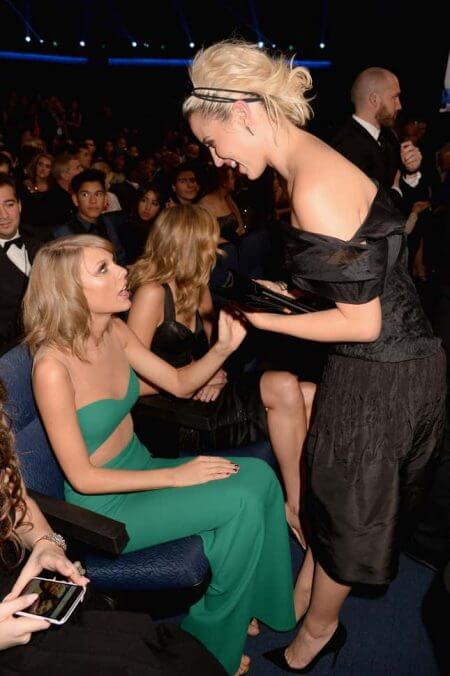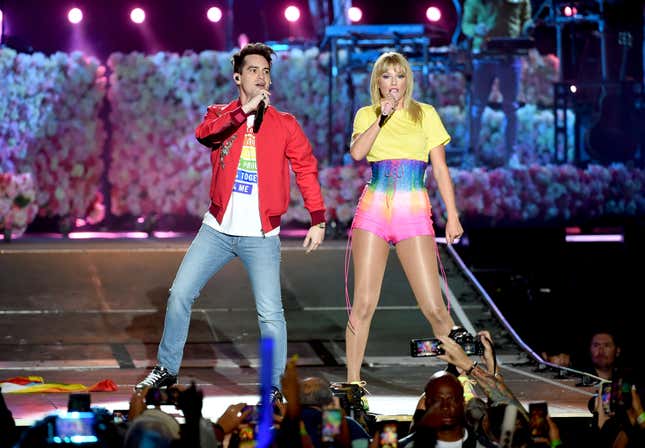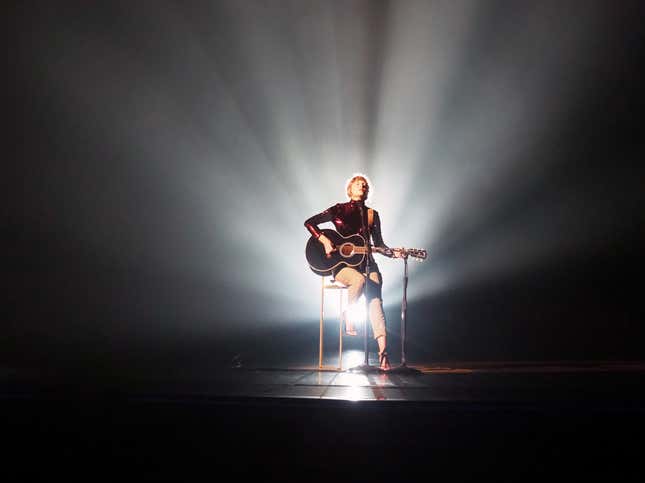The Enduring Fervor of Gaylor Fan Theory
Gaylor, a cinematic universe of suppositions about Taylor Swift's sexuality, has tried to keep to the shadows. It probably won't stay there.
In DepthIn Depth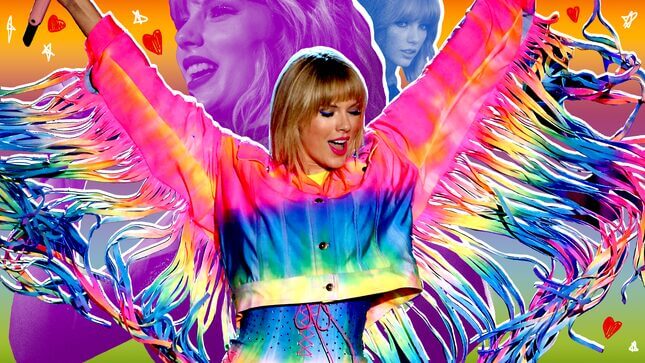
Illustration: Benjamin Currie (Photos: Getty)
Jennifer Lawrence was promoting a spy movie in 2018 when she veered far off course. At a promo stop, an audience member asked the actor how she would use high-level spy skills if she had them in real life. “I’d like to know what’s going on with Karlie Kloss and Taylor Swift, that’s the honest to God truth,” Lawrence responded. “Is nobody else curious? It’s keeping me up at night. What happened?!”
Why would Oscar-winning Lawrence give a shit that two friends weren’t actively posting about each other anymore? Her interest in investigating the Swift/Kloss undoing was akin to me looking up my ex’s boyfriend’s best friend’s wife’s cousin on Instagram. But the rumors surrounding Taylor Swift and Karlie Kloss’s public (court-side seats! performing at a fashion show!), semi-public (cooking together and posting to Instagram! vacation!), and private friendship for years supposedly pointed towards a secret gay relationship complete with beards. It even had a nice portmanteau—“Kaylor”—because the internet loves nothing more than shorthand for discussing real people like objects. But the rumors didn’t limit themselves to just one of Swift’s female friendships; Lawrence was alluding to something more accurately described as a cinematic universe of fan theories.
I loved you in spite of / Deep fears that the world would divide us — “Dancing With Our Hands Tied,” 2017
Gaylor, or the theory that Taylor Swift is gay, is a cluster of distinct yet overlapping suppositions about Swift’s sexuality (bi, pan, queer, fluid?) that hinges upon her purported romantic partners (models, actresses, musicians, friends?) and lyrical clues discovered within her music (a lotta pronoun changes, themes of yearning and secret love). It has followed Swift since her debut album was certified Platinum seven times as an undercurrent beneath mainstream celebrity media that spent over a decade fascinated by her real—and sometimes PR-appearing—relationships with men.
With a long but diligent search through any social media site, you can learn all the details of Gaylor. The Swifties who subscribe to it are of course called Gaylors (even if a Gaylor’s belief skews lesbian or pansexual), while those who chain themselves to the altar of Swift’s heterosexuality are called Hetlors. Some Gaylors want to give Swift a safe place to land when, they predict, she inevitably comes out. Others love the true crime element, tracing the timeline of public figures who’ve crossed paths with Swift. And most Gaylors treat every song, photo, piece of social media content, and interview related to Swift with the care of someone attempting to decode the Rosetta Stone. Grainy fan shots from The 1975 show in New York, an interview in which Swift said being in a room with Victoria’s Secret Angels was a “fantasy,” lyrics like “I don’t wanna keep secrets just to keep you,” literal glass boxes in music videos, lack of wedding attendances, likes and unlikes, follows and unfollows… In the words of Swift: “All at once this is enough.”
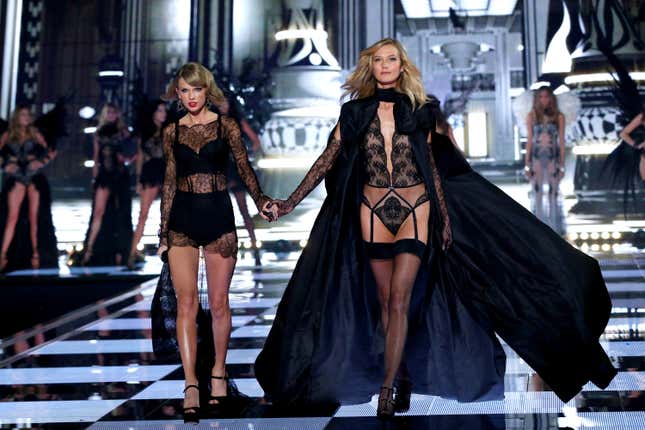
From the first guitar strum of “Tim McGraw,” Taylor Swift intentionally trained Swifties to follow her every move, especially the unspoken, as they tried to guess exactly what each lyric, color palette, or design element meant. Was honoring pioneering queer dancer Loïe Fuller during the reputation tour a sign that a coming out was…coming? Did a halo drawn over her boyfriend’s name in the graffiti of the “…Ready for It?” music video really mean the song’s subject was a stand-in for Kloss? The hints were never explicit, giving fans room to veer as they followed the breadcrumbs. Some of those breadcrumbs led to the long-standing Gaylor theory. Gaylor has stayed mostly out of the cultural conversation: a Vogue cover shared by friends was just that—nothing more. Now, at the height of her power as an artist and businessperson in full ownership of her art, the woman who blurred fans into friends can’t control the gay universe they’ve created in her image.
Taylor—and Gaylor—Find Mainstream Success
Rebecca, a 29-year-old in Texas who prefers to use a pseudonym because Swifties can be brutal online, was 17 and driving home when “Tim McGraw” came on one of the four radio signals that reached her isolated hometown. “I was living maybe two minutes from work [but] I was like, ‘I really like this song. I’m going to take the long way home,’” she recalled. Later, she drove 45 minutes to buy the album, the one with that version of “Picture to Burn,” and dropped a class in college after skipping the midterm to see a young Swift perform at a tiny, county-fair-type show. It was the beginning of an intense relationship with Swift’s music: “It sounded like my diary,” Rebecca told me.
I said, No one has to know what we do. — “WILDEST DREAMS,” 2014
In December 2014, Swift performed at the Victoria’s Secret Fashion Show, where she held hands with Kloss on the runway. Just days later, on the night before she would be nominated for three Grammy Awards for “Shake It Off,” Swift and Kloss attended The 1975 concert, where the infamous Kissgate photos of the pair possibly kissing were snapped. According to numerous Kaylor timelines, Swift also liked a bunch of Gaylor-related posts on Tumblr that night. But it wasn’t meant to be. When asked about it by reporters, Swift’s rep said, “It’s sad that on the day it’s announced Taylor has three Grammy nominations for ‘Shake It Off,’ I have to shake off this crap.” Swift allegedly unliked the Gaylor posts while liking ones criticizing the rumors. Then she tweeted: “As my 25th birthday present from the media, I’d like for you to stop accusing all my friends of dating me.”
-

-

-

-

-

-

-

-

-

-

-

-

-

-

-

-

-

-

-

-

-

-

-

-

-

-

-

-

-

-

-

-

-

-

-

-

-

-

-

-

